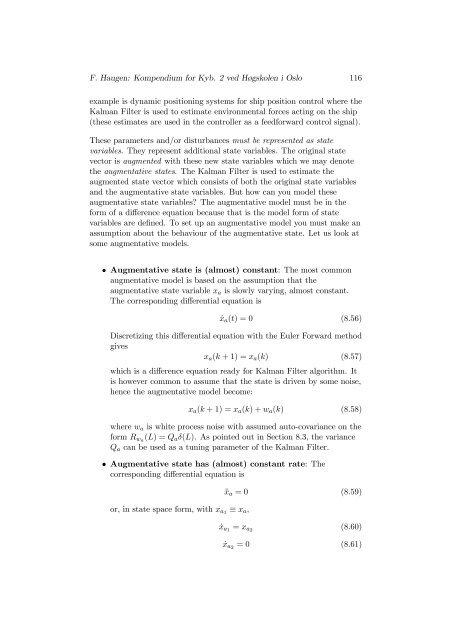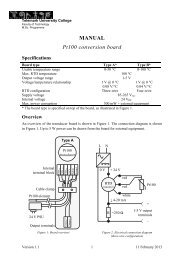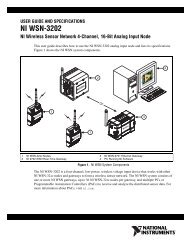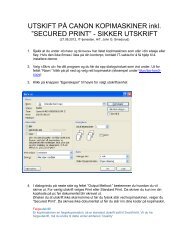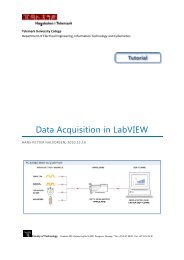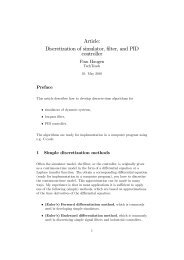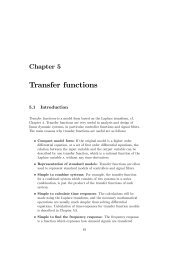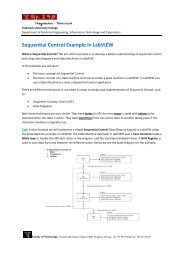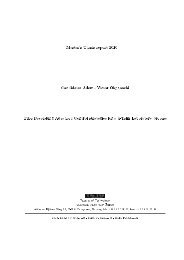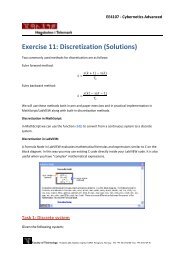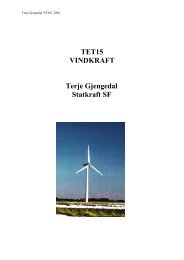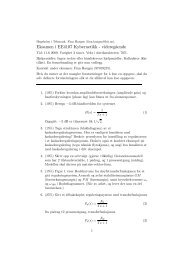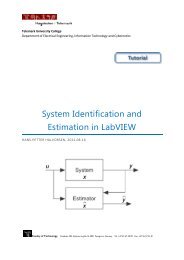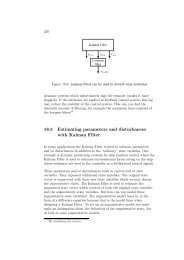State estimation with Kalman Filter
State estimation with Kalman Filter
State estimation with Kalman Filter
You also want an ePaper? Increase the reach of your titles
YUMPU automatically turns print PDFs into web optimized ePapers that Google loves.
F. Haugen: Kompendium for Kyb. 2 ved Høgskolen i Oslo 116<br />
example is dynamic positioning systems for ship position control where the<br />
<strong>Kalman</strong> <strong>Filter</strong> is used to estimate environmental forces acting on the ship<br />
(these estimates are used in the controller as a feedforward control signal).<br />
These parameters and/or disturbances must be represented as state<br />
variables. They represent additional state variables. The original state<br />
vector is augmented <strong>with</strong> these new state variables which we may denote<br />
the augmentative states. The <strong>Kalman</strong> <strong>Filter</strong> is used to estimate the<br />
augmented state vector which consists of both the original state variables<br />
and the augmentative state variables. But how can you model these<br />
augmentative state variables The augmentative model must be in the<br />
form of a difference equation because that is the model form of state<br />
variables are defined. To set up an augmentative model you must make an<br />
assumption about the behaviour of the augmentative state. Let us look at<br />
some augmentative models.<br />
• Augmentative state is (almost) constant: The most common<br />
augmentative model is based on the assumption that the<br />
augmentative state variable x a is slowly varying, almost constant.<br />
The corresponding differential equation is<br />
ẋ a (t) =0 (8.56)<br />
Discretizing this differential equation <strong>with</strong> the Euler Forward method<br />
gives<br />
x a (k +1)=x a (k) (8.57)<br />
which is a difference equation ready for <strong>Kalman</strong> <strong>Filter</strong> algorithm. It<br />
is however common to assume that the state is driven by some noise,<br />
hence the augmentative model become:<br />
x a (k +1)=x a (k)+w a (k) (8.58)<br />
where w a is white process noise <strong>with</strong> assumed auto-covariance on the<br />
form R wa (L) =Q a δ(L). As pointed out in Section 8.3, the variance<br />
Q a can be used as a tuning parameter of the <strong>Kalman</strong> <strong>Filter</strong>.<br />
• Augmentative state has (almost) constant rate: The<br />
corresponding differential equation is<br />
or, in state space form, <strong>with</strong> x a1 ≡ x a ,<br />
ẍ a =0 (8.59)<br />
ẋ a1 = x a2 (8.60)<br />
ẋ a2 =0 (8.61)


